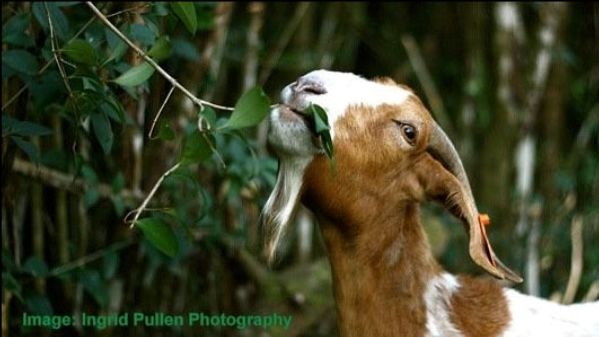 Goat eating browse (photo: ParaBoss)
Goat eating browse (photo: ParaBoss)
Plants play a role in parasite control
Key points
- Plants with anthelmintic properties, via high levels of tannins, can help lower worm burdens.
- Such plants can include grasses, grazed or fed via hay/silage, or browse plants.
- High levels of tannins are often unpalatable to livestock, however, goats are an exception.
Incorporating plants with anthelmintic properties into goats’ diets can help producers manage internal parasites in their livestock as part of an integrated management approach.
According to WormBoss, plants with anthelmintic properties, via high levels of tannins, can help lower worm burdens. Such plants can include grasses (grazed or fed via hay/silage) or browse plants.
These species not only have high tannin levels, but they offer a high plane of nutrition, which aids in supporting their resilience to withstand internal parasites.
High levels of tannins are often unpalatable to livestock, however, goats are an exception.
Grass species vary in tannin concentrations and thus their anthelmintic capabilities and success will depend on enough of certain species being consumed. The concentration of active tannins can be affected by climate, soil type and the processing of hay or silage.
The most promising forage species showing some anthelmintic properties are:
- temperate legumes such as sainfoin (Onobrychis viciifolia) in Europe, and sericea lespedeza (Lespedeza cuneata) in South Africa and the USA
- tropical legumes such asLeucaena leucocephala in Australia, and Arachis pintoi, Gliricidia sepium and Cratylia argentea in Mexico
- heather species,Erica spp. and Caluna sp. (Ericeacae) in Spain
- chicory (Cichorium intybus) in Australia, New Zealand and the USA
- sulla (Hedysarum coronarium) (Asteraceae) in Australia and New Zealand.
To incorporate these forage plants into a sward, producers could oversow existing pastures, grow as a monoculture for a worm control paddock or grow a forage bank and offer to goats as hay and silage.
Additional benefits from tannins include protection from bloat and helping protect protein from being degraded in the rumen. Caution is advised however, as high levels of tannins have been associated with lower levels of digestibility and palatability.
Browse simply means leaves, twigs or shrubs. Goats actually prefer browse to grasses and will consume up to 80% of their diet as browse if available.
Browse is generally higher in crude protein and phosphorus during the plant’s growing period however, there are some inhibitors which may limit this.
Browse species play an interesting role protecting goats from internal parasites. Firstly, through providing higher concentrations of tannins in the diet and secondly by reducing the exposure of goats to infective larvae. The latter occurs as browse plants allow goats to graze more than 15cm above ground. As larvae do not venture this far up a sward, they are therefore not ingested by goats. Basically, they separate the goat’s mouth from contact with infective larvae.
Though this provides an excellent opportunity to avoid parasites, excessive tannins may also increase a goat’s requirement for sulphur, which is problematic for hair producing goats. Additionally, goats can be rough on browse species, leading to ringbarking and broken branches. Careful management is required to preserve these important species.



